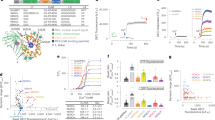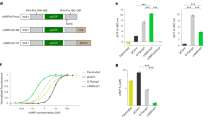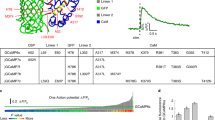Abstract
From molecules, single cells and tissues to whole organisms, our insights into Ca2+ signalling and the corresponding physiological phenomena are growing exponentially. Here, we describe the improvements that have been made in the development of the probes and instrumentation that are used for Ca2+ imaging and the expanding applications of Ca2+ imaging in basic and applied research.
This is a preview of subscription content, access via your institution
Access options
Subscribe to this journal
Receive 12 print issues and online access
$189.00 per year
only $15.75 per issue
Buy this article
- Purchase on Springer Link
- Instant access to full article PDF
Prices may be subject to local taxes which are calculated during checkout




Similar content being viewed by others
References
Pozzan, T., Rizzuto, R., Volpe, P. & Meldolesi, J. Molecular and cellular physiology of intracellular calcium stores. Physiol. Rev. 74, 595–636 (1994).
Berridge, M. J., Lipp, P. & Bootman, M. D. The versatility and universality of calcium signalling. Nature Rev. Mol. Cell Biol. 1, 11–21 (2000).
Zhang, J., Campbell, R. E., Ting, A. Y. & Tsien, R. Y. Creating new fluorescent probes for cell biology. Nature Rev. Mol. Cell Biol. 3, 906–918 (2002).
Smith, G. A., Hesketh, R. T., Metcalfe, J. C., Feeney, J. & Morris, P. G. Intracellular calcium measurements by 19F NMR of fluorine-labeled chelators. Proc. Natl Acad. Sci. USA 80, 7178–7182 (1983).
Thomas, M. V. in Techniques in Calcium Research (eds Treherne, J. E. & Rubery, P. H.) (Academic, London, New York, Paris, 1982).
Tsien, R. Y. New calcium indicators and buffers with high selectivity against magnesium and protons: design, synthesis, and properties of prototype structures. Biochemistry 19, 2396–2404 (1980).
Tsien, R. Y., Pozzan, T. & Rink, T. J. T-cell mitogens cause early changes in cytoplasmic free Ca2+ and membrane potential in lymphocytes. Nature 295, 68–71 (1982).
Tsien, R. Y. A non-disruptive technique for loading calcium buffers and indicators into cells. Nature 290, 527–528 (1981).
Plinius, G. S. Naturalis Historia Liber IX, §146 (77).
Shimomura, O., Johnson, F. H. & Saiga, Y. Extraction, purification and properties of aequorin, a bioluminescent protein from the luminous hydromedusan, Aequorea. J. Cell. Comp. Physiol. 59, 223–239 (1962).
Morise, H., Shimomura, O., Johnson, F. H. & Winant, J. Intermolecular energy transfer in the bioluminescent system of Aequorea. Biochemistry 13, 2656–2662 (1974).
Tsuji, F. I., Ohmiya, Y., Fagan, T. F., Toh, H. & Inouye, S. Molecular evolution of the Ca2+-binding photoproteins of the Hydrozoa. Photochem. Photobiol. 62, 657–661 (1995).
Prasher, D., McCann, R. O. & Cormier, M. J. Cloning and expression of the cDNA coding for aequorin, a bioluminescent calcium-binding protein. Biochem. Biophys. Res. Commun. 126, 1259–1268 (1985).
Rizzuto, R., Simpson, A. W., Brini, M. & Pozzan, T. Rapid changes of mitochondrial Ca2+ revealed by specifically targeted recombinant aequorin. Nature 358, 325–327 (1992); erratum in 360, 768 (1992).
Minta, A., Kao, J. P. & Tsien, R. Y. Fluorescent indicators for cytosolic calcium based on rhodamine and fluorescein chromophores. J. Biol. Chem. 264, 8171–8178 (1989).
Rizzuto, R., Brini, M. & Pozzan, T. Targeting recombinant aequorin to specific intracellular organelles. Methods Cell Biol. 40, 339–358 (1994).
Rizzuto, R. et al. Close contacts with the endoplasmic reticulum as determinants of mitochondrial Ca2+ responses. Science 280, 1763–1766 (1998).
Marsault, R., Murgia, M., Pozzan, T. & Rizzuto, R. Domains of high Ca2+ beneath the plasma membrane of living A7r5 cells. EMBO J. 16, 1575–1581 (1997).
Pinton, P., Pozzan, T. & Rizzuto, R. The Golgi apparatus is an inositol 1,4,5-trisphosphate-sensitive Ca2+ store, with functional properties distinct from those of the endoplasmic reticulum. EMBO J. 17, 5298–5308 (1998).
Rutter, G. A. et al. Subcellular imaging of intramitochondrial Ca2+ with recombinant targeted aequorin: significance for the regulation of pyruvate dehydrogenase activity. Proc. Natl Acad. Sci. USA 93, 5489–5494 (1996).
Villalobos, C., Nunez, L., Chamero, P., Alonso, M. T. & Garcia-Sancho, J. Mitochondrial [Ca2+] oscillations driven by local high [Ca2+] domains generated by spontaneous electric activity. J. Biol. Chem. 276, 40293–40297 (2001).
Chalfie, M., Tu, Y., Euskirchen, G., Ward, W. W. & Prasher, D. C. Green fluorescent protein as a marker for gene expression. Science 263, 802–805 (1994).
Miyawaki, A. et al. Fluorescent indicators for Ca2+ based on green fluorescent proteins and calmodulin. Nature 388, 882–887 (1997).
Romoser, V. A., Hinkle, P. M. & Persechini, A. Detection in living cells of Ca2+-dependent changes in the fluorescence emission of an indicator composed of two green fluorescent protein variants linked by a calmodulin-binding sequence. A new class of fluorescent indicators. J. Biol. Chem. 272, 13270–13274 (1997).
Baird, G. S., Zacharias, D. A. & Tsien, R. Y. Circular permutation and receptor insertion within green fluorescent proteins. Proc. Natl Acad. Sci. USA 96, 11241–11246 (1999).
Nagai, T., Sawano, A., Park, E. S. & Miyawaki, A. Circularly permuted green fluorescent proteins engineered to sense Ca2+. Proc. Natl Acad. Sci. USA 98, 3197–3202 (2001).
Miyawaki, A., Griesbeck, O., Heim, R. & Tsien, R. Y. Dynamic and quantitative Ca2+ measurements using improved cameleons. Proc. Natl Acad. Sci. USA 96, 2135–2140 (1999).
Nakai, J., Ohkura, M. & Imoto, K. A high signal-to-noise Ca2+ probe composed of a single green fluorescent protein. Nature Biotechnol. 19, 137–141 (2001).
Truong, K. et al. FRET-based in vivo Ca2+ imaging by a new calmodulin–GFP fusion molecule. Nature Struct. Biol. 8, 1069–1073 (2001).
Persechini, A., Lynch, J. A. & Romoser, V. A. Novel fluorescent indicator proteins for monitoring free intracellular Ca2+. Cell Calcium 22, 209–216 (1997).
Emmanouilidou, E. et al. Imaging Ca2+ concentration changes at the secretory vesicle surface with a recombinant targeted cameleon. Curr. Biol. 9, 915–918 (1999).
Jaconi, M. et al. Inositol 1,4,5-trisphosphate directs Ca2+ flow between mitochondria and the endoplasmic/sarcoplasmic reticulum: a role in regulating cardiac autonomic Ca2+ spiking. Mol. Biol. Cell 11, 1845–1858 (2000).
Isshiki, M., Ying, Y. S., Fujita, T. & Anderson, R. G. A molecular sensor detects signal transduction from caveolae in living cells. J. Biol. Chem. 277, 43389–43398 (2002).
Ormo, M. et al. Crystal structure of the Aequorea victoria green fluorescent protein. Science 273, 1392–1395 (1996).
Yang, F., Moss, L. G. & Phillips, G. N. Jr. The molecular structure of green fluorescent protein. Nature Biotechnol. 14, 1246–1251 (1996).
Robert, V. et al. Beat-to-beat oscillations of mitochondrial [Ca2+] in cardiac cells. EMBO J. 20, 4998–5007 (2001).
Murgia, M. et al. Cytosolic free calcium concentration in the mitogenic stimulation of T lymphocytes by anti-CD3 monoclonal antibodies. Cell Calcium 16, 167–180 (1994).
Kerr, R. et al. Optical imaging of calcium transients in neurons and pharyngeal muscle of C. elegans. Neuron 26, 583–594 (2000).
Diegelmann, S., Fiala, A., Leibold, C., Spall, T. & Buchner, E. Transgenic flies expressing the fluorescence calcium sensor cameleon 2.1 under UAS control. Genesis 34, 95–98 (2002).
Fiala, A. et al. Genetically expressed cameleon in Drosophila melanogaster is used to visualize olfactory information in projection neurons. Curr. Biol. 12, 1877–1884 (2002).
Reiff, D. F., Thiel, P. R. & Schuster, C. M. Differential regulation of active zone density during long-term strengthening of Drosophila neuromuscular junctions. J. Neurosci. 22, 9399–9409 (2002).
Yu, D., Baird, G. S., Tsien, R. Y. & Davis, R. L. Detection of calcium transients in Drosophila mushroom body neurons with camgaroo reporters. J. Neurosci. 23, 64–72 (2003).
Patterson, G. H., Knobel, S. M., Sharif, W. D., Kain, S. R. & Piston, D. W. Use of the green fluorescent protein and its mutants in quantitative fluorescence microscopy. Biophys. J. 73, 2782–2790 (1997).
Griffin, B. A., Adams, S. R. & Tsien, R. Y. Specific covalent labeling of recombinant protein molecules inside live cells. Science 281, 269–272 (1998).
Acknowledgements
The original work by the authors was supported by grants from the Italian Ministry of University, the Italian Research Council (CNR), Italian Telethon, the Italian Association for Cancer Research (AIRC), ASI, Human Science Frontier and from the European Union (EU) to T.P. and R. Rizzuto. R. Rudolf is supported by an EU Marie Curie fellowship. We are grateful to G. Carmignoto and L. Filippin for supplying artwork and to P. Magalhães for help with image processing.
Author information
Authors and Affiliations
Corresponding author
Related links
Related links
DATABASES
Swiss-Prot
FURTHER INFORMATION
Venetian Institute of Molecular Medicine
Introduction to Ca2+ measurement with fluorescent indicators
MICROSCOPES AND CAMERAS
FLUORESCENT PROBES AND FILTERS
Rights and permissions
About this article
Cite this article
Rudolf, R., Mongillo, M., Rizzuto, R. et al. Looking forward to seeing calcium. Nat Rev Mol Cell Biol 4, 579–586 (2003). https://doi.org/10.1038/nrm1153
Issue Date:
DOI: https://doi.org/10.1038/nrm1153
This article is cited by
-
Neuronal Store-Operated Calcium Channels
Molecular Neurobiology (2023)
-
Calcium signaling: breast cancer’s approach to manipulation of cellular circuitry
Biophysical Reviews (2020)
-
Release and uptake mechanisms of vesicular Ca2+ stores
Protein & Cell (2019)
-
Guidelines on experimental methods to assess mitochondrial dysfunction in cellular models of neurodegenerative diseases
Cell Death & Differentiation (2018)



